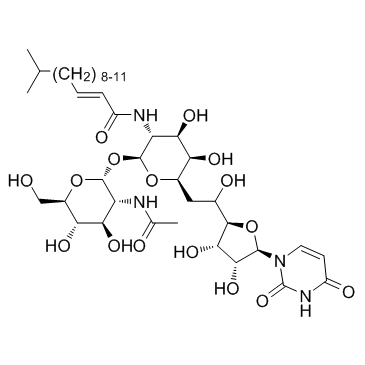Tunicamycin

Tunicamycin structure
|
Common Name | Tunicamycin | ||
|---|---|---|---|---|
| CAS Number | 11089-65-9 | Molecular Weight | 844.94 (n=10) | |
| Density | 1.4±0.1 g/cm3 | Boiling Point | N/A | |
| Molecular Formula | C39H64N4O16(n=10) | Melting Point | 234 - 235ºC | |
| MSDS | Chinese USA | Flash Point | N/A | |
| Symbol |

GHS06 |
Signal Word | Danger | |
|
Unbiased Cell-based Screening in a Neuronal Cell Model of Batten Disease Highlights an Interaction between Ca2+ Homeostasis, Autophagy, and CLN3 Protein Function.
J. Biol. Chem. 290 , 14361-80, (2015) Abnormal accumulation of undigested macromolecules, often disease-specific, is a major feature of lysosomal and neurodegenerative disease and is frequently attributed to defective autophagy. The mechanistic underpinnings of the autophagy defects are the subje... |
|
|
RIPK1 regulates survival of human melanoma cells upon endoplasmic reticulum stress through autophagy.
Autophagy 11 , 975-94, (2015) Although RIPK1 (receptor [TNFRSF]-interacting protein kinase 1) is emerging as a critical determinant of cell fate in response to cellular stress resulting from activation of death receptors and DNA damage, its potential role in cell response to endoplasmic r... |
|
|
Identification of Cell Surface Straight Chain Poly-N-Acetyl-Lactosamine Bearing Protein Ligands for VH4-34-Encoded Natural IgM Antibodies.
J. Immunol. 195 , 5178-88, (2015) B cell binding and cytotoxicity by human VH4-34-encoded Abs of the IgM isotype has been well documented. A VH4-34-IgM has recently shown a favorable early response in a phase 1 trial for treatment of B cell acute lymphoblastic leukemia. Although its B cell li... |
|
|
Lipid starvation and hypoxia synergistically activate ICAM1 and multiple genes in an Sp1-dependent manner to promote the growth of ovarian cancer.
Mol. Cancer 14(1) , 77, (2015) Elucidation of the molecular mechanisms by which cancer cells overcome hypoxia is potentially important for targeted therapy. Complexation of hypoxia-inducible factors (HIFs) with aryl hydrocarbon receptor nuclear translocators can enhance gene expression and... |
|
|
Pituitary adenylate cyclase-activating polypeptide type 1 receptor (PAC1) gene is suppressed by transglutaminase 2 activation.
J. Biol. Chem. 288(45) , 32720-30, (2013) Pituitary adenylate cyclase-activating polypeptide (PACAP) functions as a neuroprotective factor through the PACAP type 1 receptor, PAC1. In a previous work, we demonstrated that nerve growth factor augmented PAC1 gene expression through the activation of Sp1... |
|
|
Global analysis of fungal morphology exposes mechanisms of host cell escape.
Nat. Commun. 6 , 6741, (2015) Developmental transitions between single-cell yeast and multicellular filaments underpin virulence of diverse fungal pathogens. For the leading human fungal pathogen Candida albicans, filamentation is thought to be required for immune cell escape via inductio... |
|
|
Transcription Factor ATF4 Induces NLRP1 Inflammasome Expression during Endoplasmic Reticulum Stress.
PLoS ONE 10 , e0130635, (2015) Perturbation of endoplasmic reticulum (ER) homeostasis triggers the ER stress response (also known as Unfolded Protein Response), a hallmark of many pathological disorders. However the connection between ER stress and inflammation remains largely unexplored. ... |
|
|
LKB1 inactivation sensitizes non-small cell lung cancer to pharmacological aggravation of ER stress.
Cancer Lett. 352(2) , 187-95, (2014) Five-year survival rates for non-small cell lung cancer (NSCLC) have seen minimal improvement despite aggressive therapy with standard chemotherapeutic agents, indicating a need for new treatment approaches. Studies show inactivating mutations in the LKB1 tum... |
|
|
N-linked Glycosylation on the N-terminus of the dopamine D2 and D3 receptors determines receptor association with specific microdomains in the plasma membrane.
Biochim. Biophys. Acta 1853(1) , 41-51, (2015) Numerous G protein-coupled receptors (GPCRs) are glycosylated at extracellular regions. The regulatory roles of glycosylation on receptor function vary across receptor types. In this study, we used the dopamine D₂and D₃receptors as an experimental model to un... |
|
|
Membrane lipid saturation activates IRE1α without inducing clustering.
Genes Cells 18(9) , 798-809, (2013) The unfolded protein response (UPR) is an adaptive stress response that responds to the accumulation of unfolded proteins in the lumen of the endoplasmic reticulum (ER) and that adjusts the protein-folding capacity to the needs of the cell. Perturbation of ce... |